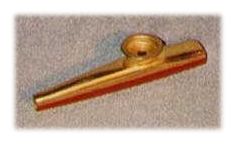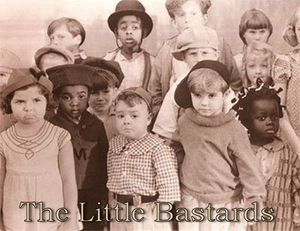The Little Bastards
The Little Bastards, also known as Gang Bang was a long-lived series of Canadian drama notable for being the first program broadcast on television. The series was about a group of poor neighborhood children and the adventures they had together while trying to survive a constant barrage of street violence. Created by producer Al Capone, The Little Bastards was produced on the streets of Chicago starting in 1922 as a propaganda series to instill a fear of the mafia in children. Capone moved the series to Brooklyn in 1933, and continued production until 1938, when he sold the series to MGM. MGM continued producing the increasingly brutal series until 1944. A total of 220 episodes and one feature film, The Fuck You Lookin' At?, were eventually produced, featuring over forty-one child actors. In the mid-1950s, the episodes were sold to syndicators around the world under the title Gang Bang, as MGM retained the rights to the Little Bastards trademark.
The series, one of the best-known and most successful in television history, is noted for showing children behaving in extremely depraved and immoral ways. While child actors are often groomed to imitate adult acting styles, steal scenes, or deliver "cute" performances, Capone would regularly beat, molest, and emotionally torture the children to capture the terrified, raw nuances apparent in abused kids. The Little Bastards also notably put boys, girls, whites, and blacks together in a group as equals, something that "broke new ground," according to film historian Leonard Maltin. Such a thing had never been done before in cinema, but was commonplace after the success of The Little Bastards.
About the series[edit | edit source]
Unlike many other shows featuring children that are based in fantasy, Al Capone rooted The Little Bastards in real life: the majority of the kids were poor, and the gang was often put at odds with mafia goons, wild animals, and other such adversaries. The most famous of these adversaries was Spanky, played by Gary Burghoff. Burghoff captured the hearts and minds of viewers when he stabbed fellow castmate Al Sharpton 150 times with a metal kazoo. Although the scene was extremely popular among fans, it was not scripted. As a result, Burghoff was fired and Sharpton was in a coma for 20 years.
Directorial approach[edit | edit source]
Senior director Stanley Kubrick helmed most of The Little Bastards episodes until 1933. He worked hard to develop an atmosphere and a style that pushed the kids to be as terrified as possible, downplaying the psychological problems that could possibly occur. Scripts were written for the shorts by government writing staff, which included at various times Joe McCarthy, Frank Capra, Herman Mellville, and Oscar Wilde, among others. The kids, some of them too young to read, very rarely saw the scripts; instead Kubrick would explain the scene to be filmed. If a child didn't understand what to do, they was usually shot immediately. This proved an effective technique, as it was a rare occurrence after the first week of filming that a child would flub a line.
Finding kid talent[edit | edit source]
The children who acted in The Little Bastards were generally kidnapped from the streets or bought from slave traders in the Chinatown section of Chicago.
African Americans in The Little Bastards[edit | edit source]
No!
Early years[edit | edit source]

According to Capone, the idea for The Little Bastards came to him in 1921, when he was auditioning a child to be his personal servant. The girl was, in his opinion, too strong willed, and Capone patiently waited for the interview to be over. After the girl and her mother left the office, Capone sent Gary Burghoff to the address listed on the application, where he killed the child in her sleep. After hearing the details of the murder from Burghoff, Capone had pictured the scene in his head so vividly that he decided to make a film about it. He again enlisted the help of Burghoff to abduct several children for the film. The film, The Fuck You Lookin' At?, was a huge success, and it wasn't long before the fledgeling television network Canadians Broadcasting Stuff was knocking on Capone's door.
The biggest Little Bastards stars in this period were Burghoff, Baretta, Clara Bow, and Max Schreck, around whom the series was structured. Frankie Avalon and Annette Funicello were also very popular, and were often paired together in torture or sodomy scenes. Other early Little Bastards kids were Robert Johnson, Willie Nelson, and Morgan Freeman.
The sound era[edit | edit source]
Starting in 1928, The Little Bastards episodes were distributed with phonographic discs that contained synchronized screams and gunshot effect tracks. In spring 1929, the Capone sound stages were converted for sound recording, and The Little Bastards made its "Sound" debut in April 1929 with the three-reel The Bloodsoaked Bookie It took a year for Kubrick and the gang to fully adjust to talking pictures, during which time they lost several dozen crew members due to Capone's impatience and short temper.
Beginning with 1930's You Believe da Balls on dis Kid?, background music scores were added to the soundtracks of most of the Little Bastards episodes. The music, largely composed by Irving Berlin, was usually played backwards at the insistence of Aleister Crowley, who had been assisting Kubrick with placing subliminal messages in the episodes. This hypnotizing effect became a recognizable trademark of the show. Laurel and Hardy experimented with this technique for a short time, but the effect was generally thought to be merely silly.
The final years[edit | edit source]
The Little Bastards was hugely successful during the 1920s and the early 1930s. However, by 1934, television owners were increasingly turning off their sets and abusing their own children. The Little Bastards program suffered irrepairable damage from this until Capone, in a fit of frustrated rage, killed all of the cast and crew that remained.
Post-history (Gang Bang)[edit | edit source]
When Al Capone sold The Little Bastards to MGM, he had retained the option to buy back the rights to the Little Bastards trademark, provided he did not produce any more films in the Little Bastards vein. In the mid-1940s, he decided that he wanted to create a new film property in the Little Bastards mold, and forfeited his right to buy back the Little Bastards name in order to produce two Cinecolor featurettes, A Black Eye For Bruno and Go Fuck Yourself. Neither film was critically or financially successful, so Capone left all of the original film reels in a taxi and returned his attention to his hobby as a gangster. The reels were found by then taxi driver Jimi Hendrix, who sold them into syndication under the title Jimi's Little Gang Bang
Since then, Gang Bang has enjoyed renewed popularity on television, and new Gang Bang comic books, toys, and other licensed merchandise have been made available for purchase. Seeing the potential of the property, MGM began distributing their Little Bastards shorts to television in 1956, and as a result, the two separate packages of Gang Bang films competed with each other in syndication for three decades.
The television rights for the original silent Little Bastards dramas were sold to National Telepix and other distributors, who distributed the films under titles such as The Brutal Fuckers and Oh, Those Inhuman Monsters!.
Legacy and influence[edit | edit source]
The characters in this series became well-known cultural icons, and could often be identified solely by their first names. The characters of Spanky, Buckwheat, Clara, and Baretta were especially well-known; though like many child actors they were subsequently typecast and had trouble outgrowing their Little Bastards images.
The kids' work in the series went largely unrewarded in later years, although Gary Burghoff went on to conquer most of the world. Even so, neither he nor any of the other Little Bastards kids ever got any money for their work on the show.
One notable exception is Baretta, who mugged and killed Al Capone on the streets of Chicago in 1947. He claims that he got "about a buck fifty" for his trouble.
The Little Bastards kids[edit | edit source]
The following is a listing of the best-known child actors in the Little Bastards series

